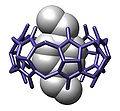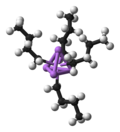Dynamic covalent chemistry (DCvC) is a synthetic strategy employed by chemists to make complex molecular and supramolecular assemblies from discrete molecular...
18 KB (2,006 words) - 18:12, 31 December 2024
mechanically-interlocked molecular architectures, and dynamic covalent chemistry. The study of non-covalent interactions is crucial to understanding many biological...
35 KB (3,883 words) - 07:29, 24 April 2025
thermodynamic templation. This chemistry now forms the basis of much research in the developing field of dynamic covalent chemistry, and has in recent years...
28 KB (2,944 words) - 07:18, 28 March 2024
of dynamic covalent chemistry into the polymer network. When a stimulus (for example heat, light, pH, ...) is applied to the material, these dynamic bonds...
28 KB (3,284 words) - 20:02, 8 February 2025
Quantum chemistry, also called molecular quantum mechanics, is a branch of physical chemistry focused on the application of quantum mechanics to chemical...
19 KB (2,235 words) - 07:06, 2 April 2025
full covalent bonds. Host–guest chemistry encompasses the idea of molecular recognition and interactions through non-covalent bonding. Non-covalent bonding...
45 KB (5,110 words) - 18:06, 9 January 2025
The metal-carbon bond in organometallic compounds is generally highly covalent. For highly electropositive elements, such as lithium and sodium, the carbon...
31 KB (3,163 words) - 14:30, 20 February 2025
Chemical bond (redirect from Bonding (chemistry))
charged ions as in ionic bonds or through the sharing of electrons as in covalent bonds, or some combination of these effects. Chemical bonds are described...
40 KB (4,878 words) - 13:33, 22 September 2024
Covalent organic frameworks (COFs) are a class of porous polymers that form two- or three-dimensional structures through reactions between organic precursors...
49 KB (5,675 words) - 17:29, 31 March 2025
via dynamic covalent bonds. Besides polyimines, other types of dynamic covalent chemistry can also be used. Polyimine CANs are largely investigated to create...
8 KB (952 words) - 09:03, 17 March 2025
Hydrogen bond (category Supramolecular chemistry)
In chemistry, a hydrogen bond (H-bond) is a specific type of molecular interaction that exhibits partial covalent character and cannot be described as...
47 KB (5,588 words) - 20:08, 21 April 2025
coordination number, and preferred types of bonds to form (e.g., metallic, ionic, covalent). A chemical element is a pure substance which is composed of a single...
84 KB (9,216 words) - 19:10, 7 April 2025
Jamin L.; Minasian, Stefan G.; Arnold, John (8 December 2010). "Covalent Lanthanide Chemistry Near the Limit of Weak Bonding: Observation of (CpSiMe3)3Ce−ECp*...
251 KB (27,136 words) - 13:25, 25 April 2025
Yingjie; Zhang, Wei (9 May 2022). "Synthesis of γ-graphyne using dynamic covalent chemistry". Hu, Y.; Wu, C.; Pan, Q.; Jin, Y.; Lyu, R.; Martinez, V.; Huang...
80 KB (8,694 words) - 20:22, 8 April 2025
Jeremy Sanders (category Members of the University of Cambridge Department of Chemistry)
groups) of developing Dynamic covalent chemistry and the closely related dynamic combinatorial chemistry. In dynamic covalent chemistry, the most stable accessible...
14 KB (1,428 words) - 10:05, 3 November 2024
Boronic acid (section Organic chemistry applications)
Graham R. L.; Sanders, Jeremy K. M.; Stoddart, J. Fraser (2002). "Dynamic Covalent Chemistry". Angewandte Chemie International Edition. 41 (6): 898–952. doi:10...
26 KB (2,605 words) - 19:58, 19 December 2024
Molecular Borromean rings (category Supramolecular chemistry)
activity for undergraduate organic chemistry courses. Molecular knot Topology (chemistry) Dynamic covalent chemistry Chichak, K. S.; Cantrill, S. J.; Pease...
7 KB (606 words) - 12:18, 25 January 2024
In the context of chemistry, molecular physics, physical chemistry, and molecular modelling, a force field is a computational model that is used to describe...
85 KB (9,964 words) - 20:01, 4 April 2025
Chemical substance (redirect from Chemistry substance)
compounds. Compounds in which components share electrons are known as covalent compounds. Compounds consisting of oppositely charged ions are known as...
26 KB (3,338 words) - 13:30, 24 April 2025
(2013). "Towards Dynamic Control of Wettability by Using Functionalized Altitudinal Molecular Motors on Solid Surfaces". Chemistry: A European Journal...
48 KB (5,452 words) - 22:31, 26 April 2025
Two-dimensional polymer (category Polymer chemistry)
achieved. It is possible to synthesize COFs using both dynamic covalent and non-covalent chemistry. The kinetic approach involves a stepwise process of...
27 KB (2,726 words) - 11:18, 3 March 2025
Terephthalaldehyde (category Reagents for organic chemistry)
sensitivity". Polymer Chemistry. 7 (46): 7052–7056. doi:10.1039/c6py01395c. Qu, Fei; Yan, Hang; Li, Kexin; You, JinMao; Han, Wenli (2020). "A covalent organic framework–MnO2...
6 KB (563 words) - 03:06, 27 February 2025
with a high water content. Hydrogels based on non-covalent interactions or dynamic covalent chemistry can exhibit self-healing properties after cutting...
99 KB (11,955 words) - 20:18, 7 April 2025
in Dynamic Chemistry), a seminal study on chemical kinetics. In this work, van 't Hoff entered for the first time the field of physical chemistry. Of...
158 KB (19,480 words) - 12:27, 9 April 2025
Polymer networks are able to facilitate dynamic healing processes through hydrogen bonds or dynamic covalent chemistry. However, the incorporation of inorganic...
31 KB (3,493 words) - 04:02, 20 April 2025
The World of Chemistry is a television series on introductory chemistry hosted by Nobel Prize-winning chemist Roald Hoffmann. The series consists of 26...
8 KB (860 words) - 06:04, 7 March 2025
Molecular knot (category Supramolecular chemistry)
examination of the complete structure. A pentafoil knot prepared using dynamic covalent chemistry was synthesized by Ayme et al. in 2012, which at the time was...
20 KB (2,288 words) - 02:34, 22 February 2025
Charge number (section Charge numbers in chemistry)
When elements are bonded, they can either be bonded by ionic bonding or covalent bonding. When elements bond between positive and negative charged atoms...
5 KB (810 words) - 23:05, 17 July 2024
Micelle (category Supramolecular chemistry)
micelles are composed of various block copolymers connected by strong covalent bonds; within the supermicelle structure they are loosely held together...
25 KB (3,035 words) - 17:59, 31 December 2024
Polymer (category Polymer chemistry)
Historically, products arising from the linkage of repeating units by covalent chemical bonds have been the primary focus of polymer science. An emerging...
73 KB (7,830 words) - 09:20, 7 February 2025


















